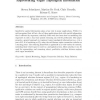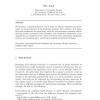120
click to vote
IJAR
2008
15 years 1 months ago
2008
Possibilistic Defeasible Logic Programming (P-DeLP) is a logic programming language which combines features from argumentation theory and logic programming, incorporating the trea...
IJAR
2008
15 years 1 months ago
2008
We develop a method for clustering all types of belief functions, in particular non-consonant belief functions. Such clustering is done when the belief functions concern multiple ...
111
click to vote
IJAR
2008
15 years 1 months ago
2008
One of the key strengths of the region connection calculus (RCC) -- its generality -- is also one of its most important drawbacks for practical applications. The semantics of all ...
119
Voted
IJAR
2008
15 years 1 months ago
2008
Qualitative spatial information plays a key role in many applications. While it is well-recognized that all but a few of these applications deal with spatial information that is a...
IJAR
2008
15 years 1 months ago
2008
This paper presents a summary of Peter Walley's theory of coherent lower previsions. We introduce three representations of coherent assessments: coherent lower and upper prev...
97
Voted
IJAR
2008
15 years 1 months ago
2008
The two most important models of inferencing in approximate reasoning with fuzzy sets are Zadeh's Compositional Rule of Inference (CRI) and Similarity Based Reasoning (SBR). ...
134
click to vote
IJAR
2008
15 years 1 months ago
2008
We address in this paper the problem of defining belief functions, typically for multi-source classification applications in image processing. We propose to use mathematical morph...
106
click to vote
IJAR
2008
15 years 1 months ago
2008
We introduce a general framework that is based on distance semantics and investigate the main properties of the entailment relations that it induces. It is shown that such entailm...
IJAR
2008
15 years 1 months ago
2008
While quantitative probabilistic networks (QPNs) allow the expert to state influences between nodes in the network as influence signs, rather than conditional probabilities, infer...
IJAR
2008
15 years 1 months ago
2008
The Dempster-Shafer (DS) theory of probabilistic reasoning is presented in terms of a semantics whereby every meaningful formal assertion is associated with a triple (p, q, r) whe...


